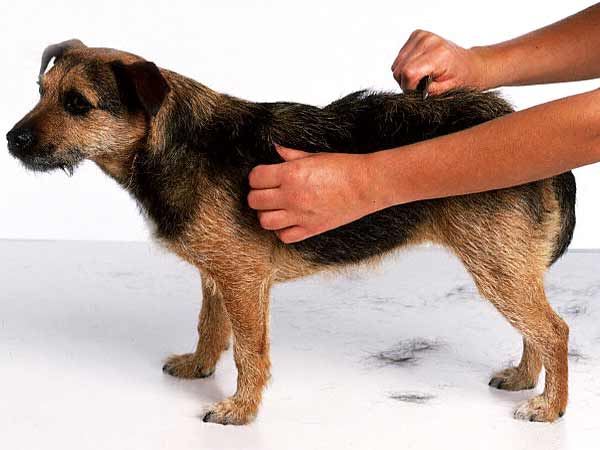Demodex canis is a little mite that lives in the hair follicles of dogs. The mites are transferred to puppies when they are snuggling up to their mother, and all dogs have them. In most cases, you don’t even know they are there but in some dogs, the mites can cause severe skin disease. Skin problems develop when something happens to stress their body or upset their immune system. The mites multiply and then you see the typical hair loss and red flaky skin.

Demodectic mange isn’t catchy, so there’s no need to worry about other dogs in your household – after all, they will already have the mites from their mom. Some research suggests that there may be some dog to dog spread, but unless the dog on the receiving end is in good health, there’s not likely to be a problem.
Types of Demodectic Mange
There are three types of demodectic mange in dogs
*Localized mange presents as small hairless patches of skin, often with some scaliness. They’re often found in just one or two areas, often on the face of young dogs. Short coated breeds such as Staffordshire Bull Terriers seem to be predisposed. Many cases of localized demodectic mange will clear up without treatment but there are topical treatments that can help to speed up the process. Around 10% of cases of localized mange will progress to the more severe generalized form.
*Generalized demodectic mange is much more serious. The patches of hairless scaly skin become larger and there is often a secondary bacterial infection. The skin can be red, itchy and very painful and it smells bad.
If a young dog has generalized demodex, then they usually recover as their immune system matures and with appropriate treatment. However it can take quite a while. It is thought that generalized mange is in some way hereditary so affected dogs need to be neutered.
It’s a different story if a mature dog develops this disease. It usually means there’s a problem with their immune system, and the cause needs to be identified. This can mean blood tests and x-rays to find out exactly what’s happening to allow the mites to multiply and cause problems.
* Demodectic pododermatitis is mange that only affects a dog’s paws. It usually has a secondary bacterial infection and it is often the hardest type of demodectic mange to treat.
Reaching a Diagnosis
Demodectic mange is diagnosed by finding mites on a skin scraping. Your vet will choose a patch of skin that is hairless and scaly and use a scalpel to gently scrape off the top layer of skin. They will usually scrape until there is a little bit of bleeding, to make sure they have scraped the hair follicles where the mites live. They’ll then look at it under a microscope to chck for mites.
Sometimes it can take repeated scrapings to find mites and in the case of demodex affecting the paws, a biopsy might be necessary.
Treating Demodectic Mange
Insecticidal injections or treatment by mouth will kill the mites, but your dog may also need antibiotic tablets or medicated washes to get his skin problem under control. Your vet will recommend the best options for him. Avoid stress, so your dog’s immune system can do its job in keeping the mites in check. This means good nutrition and parasite control.
Susan Wright is a veterinarian and freelance writer, often sharing helpful tips on what you can do for your dog before you spend time and money calling the vet.

